Integrating indoor herb gardens boosts your space with fresh aromas and nutritious herbs year-round. Choose herbs like basil, mint, and rosemary that thrive indoors, and use containers with drainage placed near natural light sources. Maintain proper watering, soil, and temperature conditions while regularly pruning for healthy growth. Incorporate herbs into your cooking and create aromatic arrangements to energize your environment. If you want practical tips to grow and enjoy your herb garden more fully, keep exploring.
Key Takeaways
- Select aromatic herbs like basil, mint, and rosemary for scent and nutritional benefits, ensuring compatibility and suitable indoor conditions.
- Use decorative containers and strategic placement near natural light to enhance aesthetics and accessibility of your herb garden.
- Maintain proper watering, lighting, and soil drainage to promote healthy growth and prevent common issues like root rot and pests.
- Incorporate herbs into daily cooking and preserve them through drying or freezing to maximize flavor and nutritional value.
- Create a sensory-rich environment by layering scents, visual displays, and arranging herbs to boost mood and indoor air quality.
Selecting the Perfect Herbs for Indoor Growth
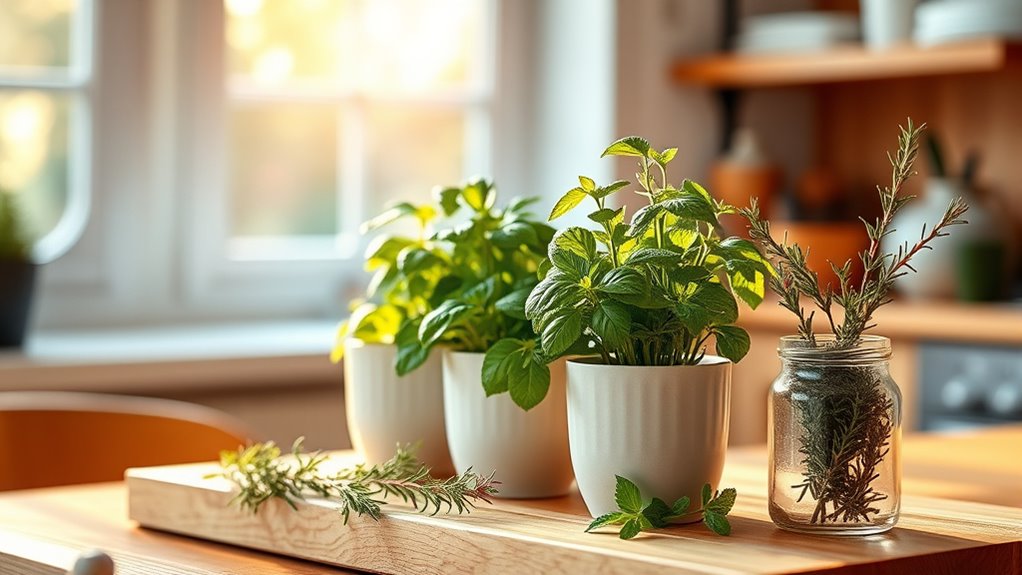
Choosing the right herbs for your indoor garden sets the foundation for success. Start by considering herb flavor profiles to match your culinary preferences—basil offers sweetness, while rosemary provides earthiness. Think about how different herbs can complement each other through companion planting; some herbs, like dill and cilantro, thrive together and can boost growth. Selecting herbs suited for indoor environments is key—look for varieties that tolerate lower light and humidity levels. Mixing herbs with similar needs simplifies maintenance and encourages healthy growth. As you plan, keep in mind the flavors you enjoy and how certain herbs can support one another naturally. Proper selection guarantees your indoor herb garden will flourish, providing fresh flavors and aromatic benefits all year round. Additionally, choosing herbs with appropriate environmental requirements can significantly improve your success rate and overall plant health.
Choosing the Ideal Container and Placement
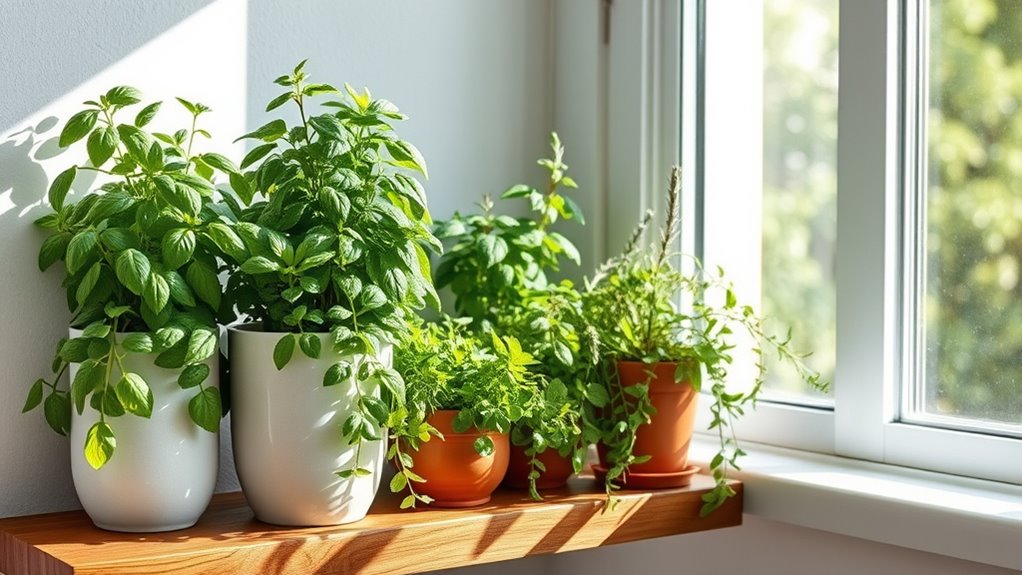
Selecting the right container and placement is essential for your indoor herb garden to thrive. When choosing decorative pot options, pick containers with drainage holes to prevent overwatering and promote healthy roots. Materials like ceramic, terracotta, or even stylish metal can add visual appeal and complement your decor. Consider placement considerations carefully: herbs need good airflow, so avoid cramped spots, and choose a location near natural light sources—such as a south-facing window—if possible. Keep herbs away from drafts or heat sources like radiators, which can stress plants. Positioning your herbs in accessible areas ensures you can easily harvest and tend to them, making gardening a seamless part of your daily routine. Proper container choice and thoughtful placement set the foundation for a thriving indoor herb garden. Additionally, understanding the grocery savings strategies can help you allocate resources for quality soil and containers.
Essential Lighting and Temperature Conditions
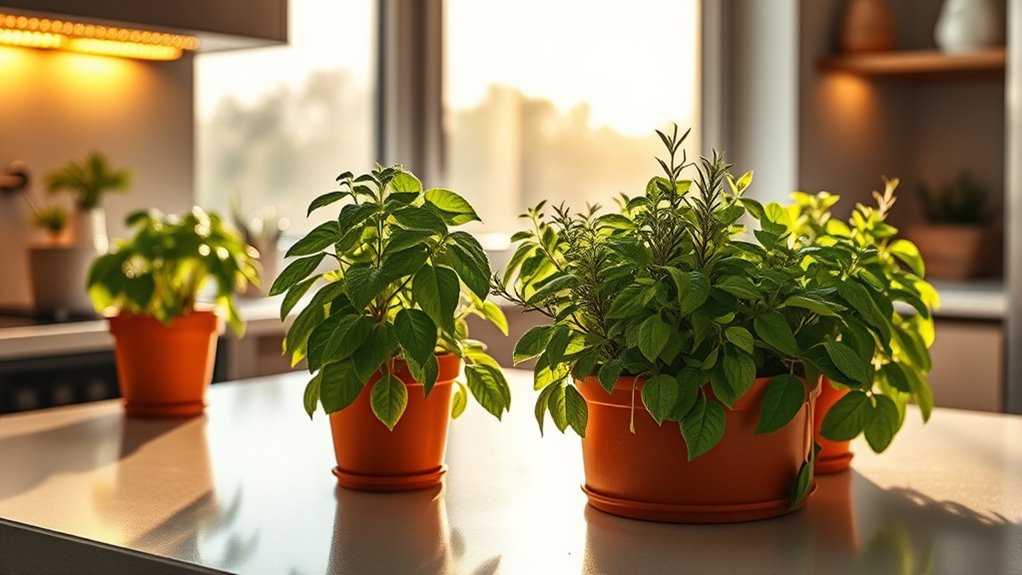
Proper lighting and temperature are essential for your indoor herb garden to flourish. Herbs need about 12-16 hours of light daily, which you can provide with grow lights if natural sunlight is limited. Use full-spectrum grow lights to mimic sunlight and ensure healthy growth. Temperature control is equally important—most herbs thrive between 65°F and 75°F. Avoid drafts and sudden temperature changes that can stress plants. To help you manage these conditions, here’s a quick guide:
| Lighting Needs | Temperature Control |
|---|---|
| 12-16 hours of light | Maintain 65-75°F |
| Use grow lights if needed | Keep away from drafts |
| Use full-spectrum lights | Avoid temperature swings |
| Position lights 12-24 inches above herbs | Use heaters or fans if necessary |
| Adjust lighting seasonally | Monitor room temperature |
Additionally, ensuring proper color temperature of your grow lights can significantly improve herb growth and health.
Soil, Watering, and Maintenance Tips

To keep your indoor herb garden thriving, paying close attention to soil quality, watering habits, and ongoing maintenance is essential. Start with soil health—use well-draining soil rich in organic matter to prevent root rot and promote healthy growth. Water your herbs consistently, but avoid overwatering; check the top inch of soil and water only when it feels dry. Adjust watering frequency based on the season and humidity levels in your home. Regularly remove dead leaves and prune your herbs to encourage lush growth. Ensure containers have proper drainage to prevent waterlogging. Keep an eye on soil condition and adjust watering routines as needed. Using a self watering plant pot can help maintain consistent moisture levels, reducing the risk of under- or overwatering. Consistent maintenance helps maintain healthy soil and vibrant herbs, ensuring your indoor garden remains productive and beautiful.
Incorporating Herbs Into Your Daily Cooking
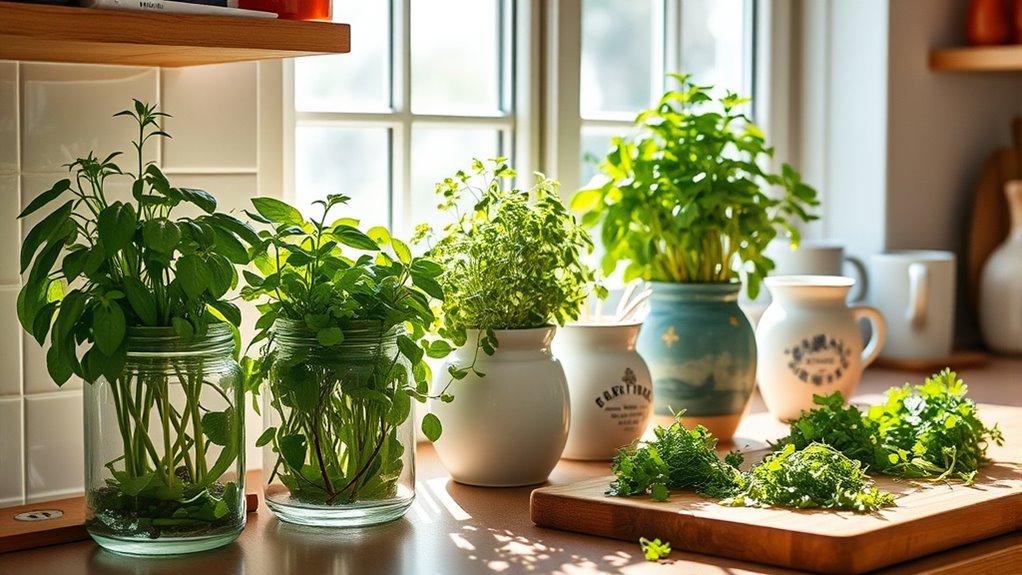
Using fresh herbs in your daily cooking adds vibrant flavor and aroma to your dishes. You should learn how to select, store, and preserve your herbs to keep them fresh longer. Experiment with creative culinary ideas to make the most of your indoor herb garden. Incorporating herb-based recipes can further enhance the nutritional value and taste of your meals.
Fresh Herb Selection
Incorporating fresh herbs into your daily cooking can elevate even simple dishes with vibrant flavor and aroma. When selecting herbs, consider their scent profiles—some, like basil and mint, offer bright, sweet notes, while others like rosemary and thyme provide earthy, piney aromas. Your indoor microclimate plays a key role in herb health and flavor; ensuring proper light, humidity, and airflow helps herbs thrive and develop their full scent potential. Choose herbs that complement your cooking style and flavor preferences, such as cilantro for fresh, citrusy notes or oregano for robust, savory dishes. Additionally, space optimization within your indoor garden can maximize herb growth and accessibility, making it easier to harvest fresh herbs daily. By understanding each herb’s unique scent profile and tailoring your indoor environment accordingly, you’ll enjoy a steady supply of aromatic herbs that enhance your daily meals.
Storage and Preservation
Ever wondered how to keep your fresh herbs vibrant and flavorful longer? Proper storage and preservation are key. Herb drying is a popular preservation technique that extends shelf life while maintaining aroma and nutrients. To visualize, imagine these options:
| Fresh in the Kitchen | Preserved for Later |
|---|---|
| Snipping herbs into salads | Drying herbs on a string |
| Placing herbs in water | Freezing chopped herbs |
| Using airtight containers | Making herb-infused oils |
| Keeping herbs in a cool, dark place | Creating herb pastes |
Additionally, ensuring proper airflow around your herbs during drying can enhance preservation air purifier maintenance.
Creative Culinary Uses
After preserving your herbs through drying or freezing, it’s time to bring their fresh flavors into your everyday dishes. Experiment with herb flavor pairings to elevate salads, soups, and marinades, adding vibrant, aromatic notes. Fresh herbs like basil, thyme, or cilantro can transform simple ingredients into flavorful masterpieces. Use culinary presentation techniques such as garnishing with sprigs or finely chopped herbs to enhance visual appeal. Incorporate herbs at different stages of cooking—adding delicate ones at the end for subtle flavor, and sturdier varieties earlier for depth. Don’t be afraid to get creative: sprinkle chopped herbs over roasted vegetables, mix them into dips, or infuse oils and butters. These thoughtful touches turn everyday meals into memorable, herb-infused culinary experiences. Creating the perfect farmhousestyle kitchen can also inspire your herb displays and presentation.
Enhancing Your Space With Aromatic Herb Arrangements

Adding aromatic herb arrangements to your indoor space can instantly elevate its ambiance and make every moment more invigorating. By selecting herbs with distinct scent profiles—like fragrant basil, mint, or rosemary—you create a sensory-rich environment that pleases your senses. These arrangements not only add visual interest but also contribute to improved indoor air quality by filtering and purifying the air. The aroma from fresh herbs can energize your space and boost your mood, making everyday activities more enjoyable. Position your herb arrangements in key areas such as the kitchen, living room, or workspace to maximize their aroma benefits. With thoughtful placement and diverse herb choices, you transform your indoor environment into a fresh, inviting sanctuary. Incorporating dynamic communication exercises for couples into your routine can further strengthen the bond you share with others in your space.
Common Challenges and Troubleshooting
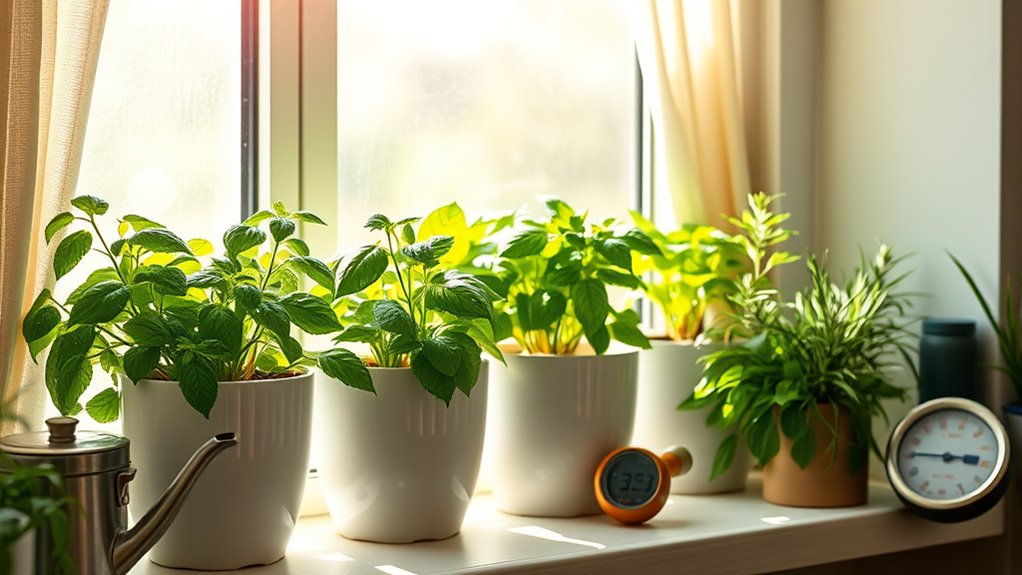
Growing healthy indoor herb gardens can present a few common challenges, but identifying and addressing these issues early can keep your herbs thriving. Pest prevention is vital; watch for tiny insects or sticky residue, and isolate new plants. Soil contamination can occur if you reuse potting mix or introduce infected soil, so always use fresh, high-quality soil. Overwatering leads to root rot, while underwatering causes wilting, so monitor moisture levels closely. Insufficient light can stunt growth, so ensure your herbs get enough sunlight or supplement with grow lights. Regularly inspect plants for pests and avoid soil contamination by using sterilized soil. Keep your garden clean and well-maintained, and your herbs will flourish.
Creative Ideas for Expanding Your Indoor Herb Garden
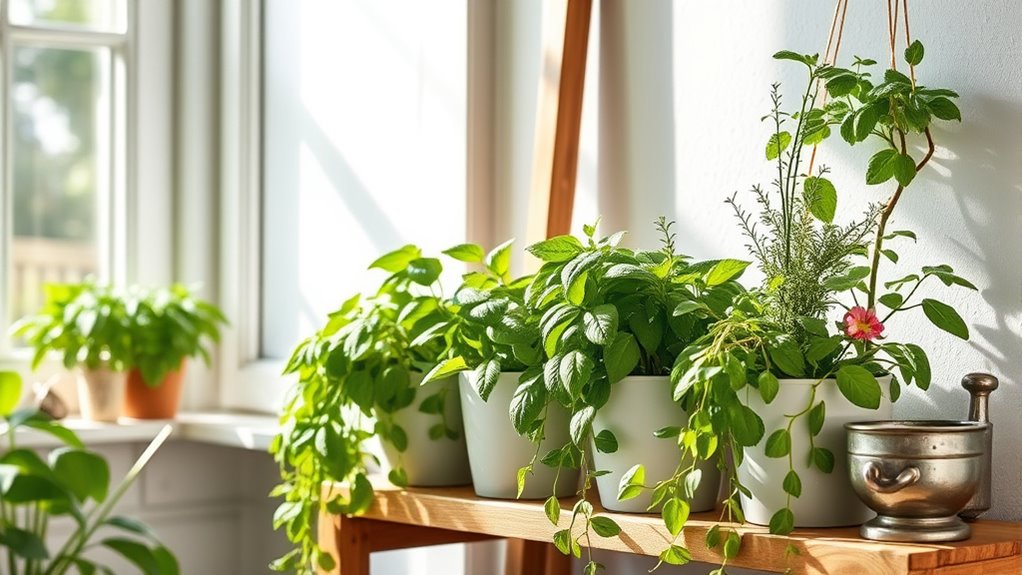
Expanding your indoor herb garden offers a fun way to boost your culinary options and enhance your space. One creative idea is herb scent layering, where you arrange different herbs with complementary aromas together to create a fragrant, multi-sensory experience. Consider grouping basil, mint, and thyme for a fresh, lively scent that fills your kitchen. You can also explore decorative herb displays by using unique containers, hanging baskets, or vertical planters to add visual interest. Mixing textures and colors makes your garden more attractive and inspiring. Incorporate small chalkboard tags or labels for easy identification and a charming touch. These ideas not only maximize your herb collection but also turn your indoor garden into a lively, aromatic centerpiece.
Frequently Asked Questions
How Can I Prevent Pests in My Indoor Herb Garden?
To prevent pests in your indoor herb garden, you should start with good hygiene and regular inspection. Use companion planting by placing pest-repelling herbs like basil or mint nearby. Incorporate natural repellents such as neem oil or essential oils to deter pests, avoiding chemical pesticides. Keep your garden healthy by watering appropriately and removing affected leaves. This proactive approach keeps pests at bay while supporting a thriving, fragrant indoor herb garden.
What Are Eco-Friendly Pest Control Options for Indoor Herbs?
You can use eco-friendly pest control options by applying natural repellents like neem oil or garlic spray to deter pests without chemicals. Biological control is also effective; introducing beneficial insects such as ladybugs or predatory mites helps keep pest populations in check. These methods protect your indoor herbs safely, maintaining their aroma and nutrition while reducing environmental impact. Always follow application instructions for safe and effective pest management.
How Do I Harvest Herbs Without Damaging Future Growth?
To harvest herbs without harming future growth, focus on proper pruning techniques and timing. Use sharp scissors or pruning shears to cut just above a leaf node, encouraging new growth. Harvest herbs in the morning when their oils are most concentrated, and avoid removing more than one-third at a time. Regular, gentle pruning helps maintain healthy plants and guarantees continuous harvests, supporting your indoor garden’s vigor.
Can I Grow Herbs Indoors Year-Round Without Special Equipment?
Imagine your indoor garden as a cozy oasis, thriving year-round. Yes, you can grow herbs indoors without fancy equipment by choosing containers that suit your space and guarantee proper drainage. Focus on seasonal lighting, like south-facing windows or grow lights, to mimic sunlight’s warmth. With attentive watering and smart container selection, your herbs will flourish, turning your home into a fragrant, nourishing paradise, no matter the season.
What Are the Benefits of Pairing Herbs for Aroma and Nutrition?
Pairing herbs for aroma enhancement and nutritional synergy boosts your indoor garden’s benefits. You’ll enjoy more inviting scents and richer flavors, making your space more pleasant. Combining herbs like basil and mint can amplify aroma, while mixing parsley and cilantro enhances nutritional value. These pairings not only elevate your meals but also create an engaging sensory experience, encouraging you to use fresh herbs more often. It’s a simple way to maximize your indoor herb garden’s potential.
Conclusion
Now that you know the essentials, your indoor herb garden is ready to flourish. But the true magic lies in what you’ll discover next—unexpected flavors, irresistible aromas, and the joy of nurturing life indoors. Stay attentive to your plants’ needs, and you’ll reveal a world of culinary and sensory delights you never imagined. Are you prepared to turn your space into a sanctuary of freshness and aroma? The journey has just begun.









